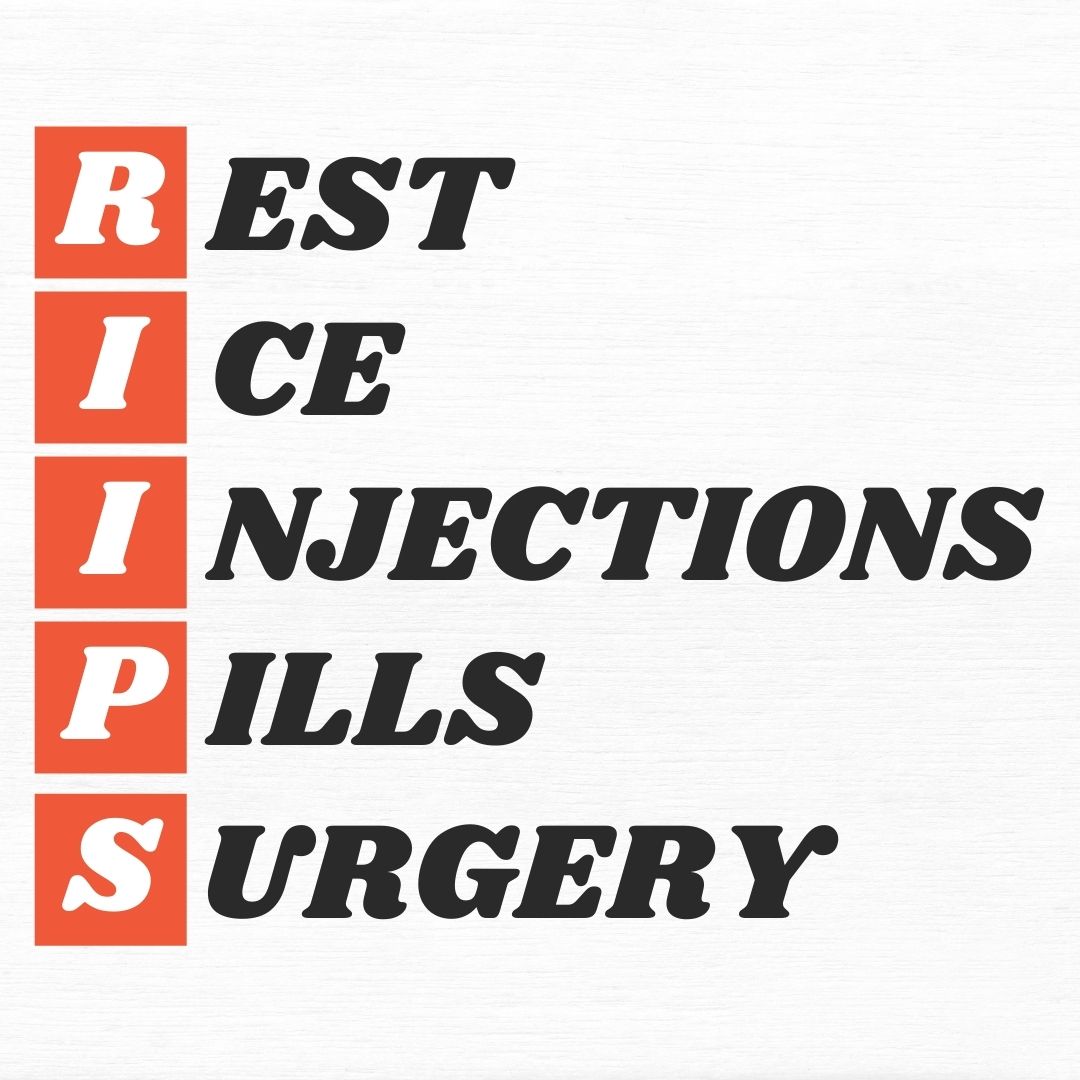RIIPS: Why Rest, Ice, Injections, Pills, and Surgery Shouldn’t be Your Only Options

When you’re facing chronic pain and joint discomfort, don't get caught in the trap of looking for a quick fix. Functional training, which focuses on solutions for pain through muscle and movement pattern development, is a better long-term solution.
Table of Contents
This post contains affiliate links for book recommendations. This does not affect the price you pay, and Upright Health receives a small commission that supports the development of future content.
What are RIIPs?
When you’re dealing with chronic pain from muscle or joint imbalance and dysfunction, it’s easy to think your only options are conventional interventions promoted by many Western doctors. But I’m here to tell you not to get caught up in rest, ice, injections, pills, and surgery—or what I call RIIPS.
As you may be aware, when swimming in the ocean, you should avoid "rip currents" (or "rips" for short).
If you get caught in a rip, you’ll be sucked out to sea. If you're a calm and strong swimmer, you can escape the rip current with some forethought and get yourself back to shore. But if you panic, you'll flail against the rip and drown as you exhaust yourself. Sadly, this is what happens to a lot of people caught in rip currents.
When you have chronic joint pain, there are strong currents that you need to be mindful of as well. I call them RIIPS for short, which, again, stands for rest, ice, injections, pills, and surgery.
If you have chronic pain and get caught in RIIPS, you'll drown in frustration and rising levels of pain and disability.

The Ups and Downs of RIIPS
Each of these conventional treatments is familiar to anyone with long-standing chronic pain. Let's take a quick look at why each treatment option can leave you frustrated and flailing.
Rest
Rest is the best medicine, right? Many physicians will tell you that the best way to solve your aches and pains is to rest, but the research on that doesn't pan out. It used to be the standard recommendation for back pain, until researchers showed that it was bad advice and led people to atrophy and getting worse.
Watch: How to Fix Back Pain (4 Simple Exercises)
If you want to get stronger, be more mobile, and feel ready to meet the challenges of daily life, long-term rest is guaranteed to fail. Muscle function (and therefore movement ability) does not improve with long-term rest; on the contrary, muscles atrophy rapidly when immobilized. Put succinctly, ATROPHY ACHES.
The only thing that improves muscle function and movement ability is movement. You cannot build stronger muscles through rest. You cannot improve your flexibility with rest.
You can improve both of those traits with concerted, consistent functional training.
Ice
Ice will allegedly reduce inflammation according to some healthcare practitioners. While there are several theories for why ice may relieve pain, there's actually scant research to back them up. In fact, whether inflammation is the cause of chronic pain is itself controversial, even when looking at "inflammatory" conditions like tendonitis.
My experience with clients and ice (as well as research studies on cryotherapy) has shown a totally unpredictable effect (positive for some, neutral for some, and annoying and painful for others). For me personally, ice is only tolerable as a short-term treatment for a forceful impact that results in swelling (like a hockey puck to the ankle). For my chronic and recurring pain, ice has always been a waste of time.
The upside of using ice on yourself is that it’s cheap and easy, and as long as you pay attention, it's pretty hard to hurt yourself with it.

How long before this ice relieves my inflammation? Photo by Anne Nygård on Unsplash.
Ice does not build muscle strength. It does not improve flexibility. At best it reduces the sensation of pain and reduces inflammation that may or may not be contributing to your movement problems. Long-term, it does not fix weak and inflexible muscles.
Injections
Injections to relieve pain come in a couple flavors.
Steroid injections have a spotty track record for pain relief. They may reduce inflammation (but again we need to consider whether that's the cause of joint pain). Steroid injections also introduce negative risks, like damage to the tissues near the injection site and impeded healing.
At best, steroid injections may reduce inflammation that may or may not contribute to your pain and movement problems. But steroid injections done multiple times in the same area lead to deterioration of the tissues. That's why responsible doctors don't recommend you use steroid injections too often.
Long term, steroid injections aren't a good solution. Even if a steroid injection reduces pain, you still need to identify and retrain the muscle weaknesses and imbalances that create limits in your daily and athletic activities.
See also: ATM Theory: Your Joint Pain May Actually be Muscle Pain
Platelet-rich Plasma (PRP) injections claim to promote healing and regeneration, but the evidence for that is weak at best.
Even if we assume they do help you regrow the tissues inside joints, you still need to address the lack of muscle function that led to the alleged "wear and tear." And you will still need to identify and retrain the muscle weaknesses and imbalances that create limits in your daily and athletic activities.
See also: Are PRP Injections Worth It?
Pills
Pills come in a dizzying array of options. Over-the-counter pain medications, like acetaminophen or ibuprofen, do nothing to address the root causes of your discomfort. At best, they mask your pain and reduce the inflammation that may or may not be related to your pain. Long-term use of NSAIDs brings with it all kinds of potential negative side effects.
Opioids, once the darling of the medical community for treating chronic pain, have now shown themselves to carry a high risk of addiction and dependence. Long-term opioid use is less effective than NSAIDs for pain relief (due to tolerance building) and is also associated with hyperalgesia (called Opioid-induced Hyperalgesia). In other words, taking opioids can make you feel MORE pain than you had to start. And if you don't recognize the problem, you can overdose on opioids.
Relying on pain pills is just not a good idea for many reasons including:
- You numb yourself to the effects of your daily movement patterns and habits (whether positive or negative).
- You numb yourself to the effects of exercise in general.
- You numb yourself to the effects of specific exercises on your body (whether positive or negative).
- You expose yourself to multiple side effects that can damage organs and increase your perceived pain levels.
Pain pills don't address your muscle function. They don't improve your movement capacity in the long-term. They only numb you to important signals.
Pain can help you better understand what functional training exercises your body needs (and which ones you don't need at the moment). Numbing that pain means you'll be flying blind.
Surgery
Surgery is the most invasive option, and it should always be the last option you consider. Throughout medical history, many orthopedic surgeries have turned out to be elaborate, expensive, and risky procedures with little benefit to patients (knee meniscus surgery for one example or spinal surgeries for another). All of these debunked surgeries had been touted as "highly effective", until rigorous long-term research showed them to be only as effective as placebo treatment. Unfortunately, surgeries also entail a much higher risk of negative effects than a placebo.
That's to say nothing of the opiate addiction risk that comes with the prescriptions following invasive procedures.
See also: Why you DON’T Need Orthopedic Surgery for Joint Pain
Even after joint surgery (whether it's considered invasive or minimally invasive), you still need to restore muscle function.
Immobilizing any joint for several weeks does lead to severe muscle atrophy (see the Rest section up above). Bed rest for several weeks or months will have clear negative effects on the muscles surrounding whatever joint you have "fixed" surgically. You'll need to spend months (or longer) with physical training or functional training to improve muscle function and joint range of motion.
For some rare people, surgery may feel like a magic bullet that requires no extra input, physical therapy, or exercise to get back to normal activity levels. But that's not an outcome you should count on.
And if it fails, some people end up falling down a horrifying rabbit hole of increasingly invasive and expensive follow-up procedures that leave them with the same or more pain, disability, and dysfunction.
To paraphrase spinal surgeon David Hanscom (Amazon affiliate link), before you consider surgery, you should spend at least six months working hard and creatively to fix the lifestyle habits, movement patterns, and muscular issues that contribute to your problems.
When RIIPS May Help
To be clear, there are times when some of the pain treatments of RIIPS might make sense, particularly in the short term.
But if you have chronic joint pain, it's important to view all of these with a discerning eye and an understanding of your long-term game plan.
The first four options of RIIPS (rest, ice, injections, pills) do not address root causes of pain and are not a long-term path out of dysfunction. It's best to view them only as short-term fixes. None of them will help you build strength, flexibility, and function in the long run. Only movement and exercise can do that!
As for surgery, orthopedic surgeons often believe that their procedures address root causes of pain, but historically that has rarely (if ever) been true. Many surgeons have realized this over the years and written about this massive blindspot. For example, read the books Surgery: the Ultimate Placebo by Dr. Ian Harris and Back in Control by Dr. David Hanscom. These books provide clear examples of medical overconfidence in surgical procedures and the challenges this attitude presents for patients in pain and their doctors.
In summary, don't get caught in RIIPS.
Use functional training to improve your overall quality of life. Combine that with strategies, habits, and lifestyle changes that will help you improve your mental health, emotional stability, and muscular strength and flexibility in the long run.
---
Suffering from joint pain? Read Why you DON'T Need Orthopedic Surgery for Joint Pain
Dive deeper: Learn How to Identify Muscle Imbalances and Dysfunction.
---

